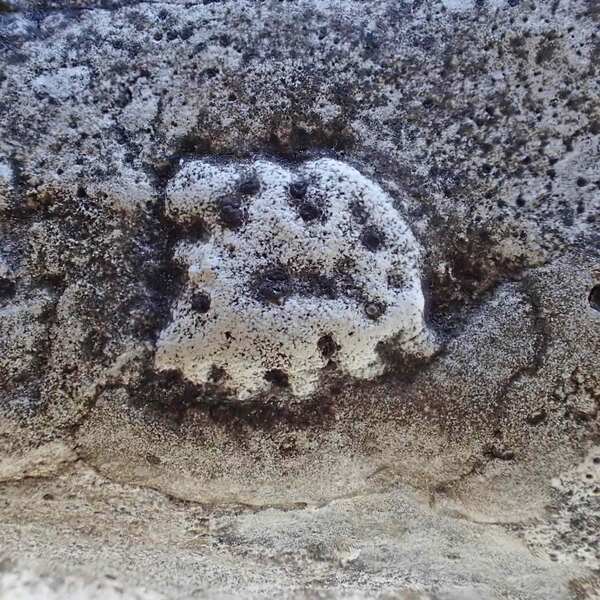Poeltinula cerebrina (DC.) Hafellner
Beih. Nova Hedwigia, 79: 330, 1984. Basionym: Opegrapha cerebrina DC. in Lamarck & de Candolle - Fl. Franç., éd. 3, 2: 312, 1805.
Synonyms: Buellia cerebrina (Dc.) Th. Fr.; Encephalographa cerebrina (DC.) A. Massal.; Encephalographa cerebrina f. candida Anzi; Encephalographa cerebrina f. steriza Anzi; Encephalographa cerebrina subsp. parvocalcicola Asta & Cl. Roux; Lecidea cerebrina (DC.) Schaer.; Lithographa cerebrina (DC.) Leight.; Patellaria cerebrina (DC.) Duby; Poeltinula cerebrina subsp. parvocalcicola (Asta & Cl. Roux) Clauzade & Cl. Roux
Distribution: N - Ven, TAA (Nascimbene & al. 2022), Lomb, Piem, Lig.
Description: Thallus crustose, usually episubstratic, rather thick, chalky white, sometimes with a bluish hue, continuous to areolate, poorly delimited, rarely hemiendosubstratic and poorly evident. Apothecia 0.5-2 mm across, black, sessile, very variable in outline (rounded, elliptical, angular to branched and almost lirelliform), with a slit-like to expanded, sometimes umbonate disc and a raised proper margin. Proper exciple thick, dark reddish brown. K+ intensifying reddish; epithecium olive-grey or olive-brown, K-, N+ red; hymenium colourless, 70-120(-160) µm high, I+ blue; paraphyses 1.5-3 µm thick at mid-level, branched in upper part and anastomosing, the apical cells slightly swollen, to 5 µm thick, with a sharply delimited dark cap; hypothecium dark reddish brown, up to 100 µm thick. Asci 8-spored, clavate, fissitunicate, with a well-developed, I+ pale blue tholus surrounded by a I+ blue gelatinous layer, lacking an ocular chamber, Rhizocarpon-type. Ascospores 1-septate, constricted at septum, at first hyaline then dark brown to violet-black (but almost colourless around the septum), N+ red, oblong-ellipsoid, 14-24 x 7-12(-14) µm, with a distinct epispore and a colourless gelatinous sheath. Photobiont chlorococcoid. Spot tests: K-, C-, KC-, P-, UV-. Chemistry: without lichen substances.Note: on steeply inclined faces of compact calciferous rocks, especially dolomite, but also on rocks which are poor in calcium, mostly in upland areas.
Growth form: Crustose
Substrata: rocks
Photobiont: Trentepohlia
Reproductive strategy: mainly sexual
Commonnes-rarity: (info)
Alpine belt: rather rare
Subalpine belt: rare
Oromediterranean belt: absent
Montane belt: very rare
Submediterranean belt: absent
Padanian area: absent
Humid submediterranean belt: absent
Humid mediterranean belt: absent
Dry mediterranean belt: absent

Predictive model
Herbarium samples

Photo uploaded by P. Cannon - CC BY-SA NC - Source: https://fungi.myspecies.info/sites/fungi.myspecies.info/files/P4230449.jpg
United Kingdom, Yorkshire
Growth form: Crustose
Substrata: rocks
Photobiont: Trentepohlia
Reproductive strategy: mainly sexual
Commonnes-rarity: (info)
Alpine belt: rather rare
Subalpine belt: rare
Oromediterranean belt: absent
Montane belt: very rare
Submediterranean belt: absent
Padanian area: absent
Humid submediterranean belt: absent
Humid mediterranean belt: absent
Dry mediterranean belt: absent

Predictive model
| Herbarium samples |

 INDEX FUNGORUM
INDEX FUNGORUM
 GBIF
GBIF
 DOLICHENS
DOLICHENS



